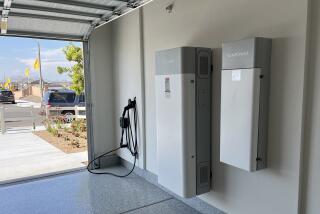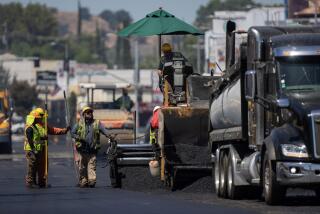Power grid and patience are strained as heat wave continues

Across Southern California, the unrelenting heat wave tested both emotions and the region’s power grid.
In northeast Los Angeles, students walked out of class when the air conditioning went out. Across town, the Los Angeles Department of Water and Power reported that — as thousands went without power — one of its transfer stations caught fire under the strain of triple-digit temperatures.
And to the east and south, furnace-hot winds and a furious rainstorm added to the misery index.
The DWP said Monday’s energy demand record was shattered Tuesday, with electrical usage peaking at nearly 6,400 megawatts. Monday’s peak was about 6,200 megawatts.
Randy Howard, senior assistant general manager, said the utility has enough power supply to meet the high demand, but issues arise when it tries to deliver that energy to households.
As heat lingers into the evening, electrical equipment doesn’t have a chance to cool down as Angelenos continue to run their air conditioning on full blast. That adds to the risk of equipment failure, Howard said. Most outages tied to the heat are blown fuses, but some require crews to replace transformers — a process that can take 10 to 15 hours.
Indeed, a fire at a DWP distribution center in Van Nuys was sparked by an overheated circuit breaker. Residents reported seeing flames and smoke rising from the facility on Oxnard Street and Tyrone Avenue about 2 p.m., said Brian Humphrey, a spokesman for the Los Angeles Fire Department.
The blaze was extinguished by about 3:30 p.m. and was confined to one piece of electrical equipment, Humphrey said. No one was injured.
Power blackouts were reported in some of the area’s hardest hit by the five-day heat wave, including Sun Valley, Burbank and Sherman Oaks, where temperatures have reached 105 degrees. Other areas that were affected Tuesday included Brentwood, Pacific Palisades, the San Fernando Valley and West L.A.
DWP spokesman Joseph Ramallo said the power system was faring better compared with the last major heat wave eight years ago. Last time, the utility suffered about 900 failed transformers over the course of 10 days — an average of 90 a day. So far, the department estimates about 50 transformers will have failed in the five days since the heat wave started Friday, Ramallo said.
The Los Angeles Unified School District was having issues with air conditioning districtwide, logging nearly 500 calls for service for older air-conditioning systems.
Monica Whalen tweeted “a classroom @ Franklin High” with a photograph of the classroom and a headline reading “103.” The student said some classmates had walked out of their fifth-period class and headed to a school auditorium that they presumed was air conditioned, before being moved to another classroom.
The Inland Empire experienced wacky weather, including wicked winds that sent up huge plumes of dust and wild thunderstorms that toppled trees and flooded roads.
Street flooding was reported in Wildomar, and Elsinore High School suffered roof damage. Lightning struck at least one home in Crestline, setting it on fire. In Ontario, residents reported seeing a huge cloud they believed was a dust storm, though there was no official confirmation from weather officials.
Wind gusts reaching 50 mph toppled trees in El Cajon. There were reports of wind, rain and downed trees in much of San Diego County.
Near Qualcomm Stadium in Mission Valley, rescuers searched Tuesday night for two people who it was feared had been swept away by the rain-swollen San Diego River. They were later found unharmed.
The sudden storm was the product of Hurricane Odile, which pushed monsoonal moisture and easterly winds into the region, said Brett Albright, a meteorologist with the National Weather Service.
Similar weather patterns are expected to continue Wednesday.
@VeronicarochaLA
@LATimesemily
tony.perry@latimes.com
@LATsandiego
Times staff writers Joseph Serna and Adolfo Flores contributed to this report.
More to Read
Start your day right
Sign up for Essential California for news, features and recommendations from the L.A. Times and beyond in your inbox six days a week.
You may occasionally receive promotional content from the Los Angeles Times.






